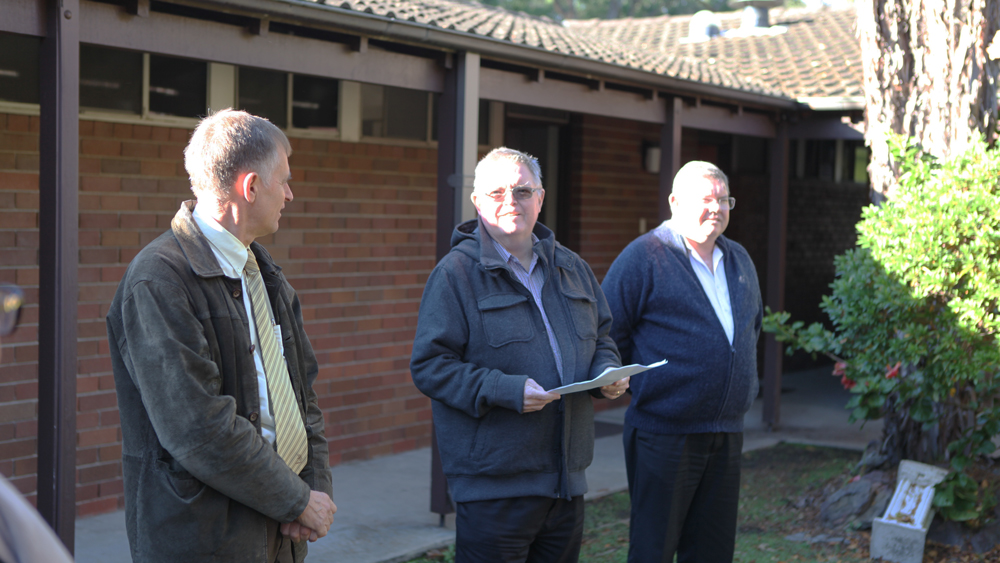This is a copy of the speech given by Dr David Thiele at the South Pacific Division’s Mission Hostel decommissioning service. Dr Thiele recently returned to Australia after working at Pacific Adventist University in Papua New Guinea, since 2000.
The Seventh-day Adventist Church understands itself to have a special responsibility to take the Gospel to the world—the final task for the church to complete before the return of Jesus (Matthew 24:14). It recognises its own work and mission in Revelation’s portrayal of three angels flying in mid-heaven, having “the eternal gospel to proclaim to those who live on the earth (Revelation 14:6, 7-12). This task is taken as seriously in the South Pacific Division as it is anywhere else in the world, and the Mission Hostel being decommissioned today (June 21), has played an important part in that task here.
The story of Adventist missionaries going from the South Pacific home fields to the mission fields begins in 1900 with the sending of New Zealander, Albert H Piper, to the Cook Islands (Rarotonga). From that point on the number of missionaries increased as territory after territory was targeted. The heyday of missions in this part of the world was probably the period from the 1950s to the 1970s. The Second World War had ravaged much of the mission territory and the need for development in the South Pacific Island nations was obvious to all. The pre-independence period for many of these nations saw a relative ease of entry for missionaries, and large numbers of workers spent at least some of their careers in the mission field.
Prior to the establishment of this mission hostel, the church had a mission cottage further up Fox Valley Rd—roughly opposite the Division office. A photo, published in the Adventist Record of March 30, 1970, taken from the hospital tower many years earlier shows it—but the area is so undeveloped that it is difficult to tell exactly where it was located. That building was heavily utilised, often being filled to the verandas. Families with small children were often crammed into a single room and all the families shared common kitchen and dining facilities. Writing of this original “mission cottage” in the Record of July 16, 1951, Stella Parker Peterson describes it as “wholly inadequate”.
Evidently, Pastor W G Turner, Australasian Union Conference President from 1946 to 1948 agreed and put in motion plans to develop the present mission hostel—or at least the self-contained units at the front section. The measure of his commitment to this project can be recognised when we consider the shortage of building materials and the costs involved in a project of this size in the immediate post-war context.
The project was completed and a report on the it written up in the Record in July 1951, complete with a photo of the hostel taken from the other side of Fox Valley Road. The author opens her report on “An Unusual Building” with this comment:
The building you see on this page is not just another building. I like to think that angels from the courts of heaven are specially commissioned to hover over this structure which edges up to the bush, and where dwell, as occasion demands, those who have been on His service in some of the earth’s most difficult fields; who are heralding His coming to the uttermost parts of the earth. [pullquote]
This enraptured response to the new building must be set in its historical context as well. Furlough for missionaries at this time was a six month long affair. Adequate accommodation during this period was one of the most urgent needs for missionaries on furlough. It must also be remembered that Sydney was Australia’s international hub then to a far greater extent than it is today. For Australian missionaries, a return to Sydney was almost mandatory. The location here was ideal for missionary families: close to church headquarters, medical facilities and schools—for the children to attend while on furlough.
The hostel was completed and missionaries from all over the south pacific started to occupy it–the first being A J Dyason, home from Fiji. In March 1951, Ron Ellison and his family arrive here on leave from Papua. In 1952 Pastor C A Hart, on leave from the Coral Sea Mission stayed at the hostel. While he was here, his daughter Paula married Arthur Judd. The reception was held at the hostel. I am not sure if any other wedding receptions were held at the hostel, but certainly the hostel was the base for other weddings. I know of two specifically: Roy Naden in 1955 and our own son, Christopher in 2006.
Record specifically mentions other missionary families who stayed at the hostel in the 1950s and 1960s: The Taylors, Newmans, Grays, Tonkins, Harveys, Specks, Parkinsons, and Parkers. Of course, there were many others not noted by the Record.
Over time the hostel was developed, refurbished and extended. The motel-style flats at the back were added in 1968. The old coin operated gas heaters were phased out and replaced. There are stories of missionaries arriving from the tropics in mid-winter and not having enough coins on their first night home to keep the heaters going!
The decommissioning of the hostel will inevitably be seen by some as a dark day in Australian Adventist mission history—signifying a loss of vision, a loss of commitment to mission, a loss of care for missionaries, the triumph of finance over mission. Any such interpretation is plausible but scarcely necessary. It does signify the end of an important chapter in our mission history. The era of large scale expatriate missions in the island nations of the south pacific is certainly over. Proud independent nations are more reluctant to allow expatriates in to their territory than colonial administrators were. Rising educational standards in these nations means that increasingly national workers are taking on the tasks once done exclusively by expatriates. Correspondingly, the requirements for expatriates allowed to work these nations is also rising. It is sobering to think that virtually none of the founding faculty at Pacific Adventist College (as it then was) would have been adequately qualified to be employed at Pacific Adventist University today. This smaller group of missionaries do not necessarily return to Sydney. It is easy to return to Perth, Brisbane or Cairns without coming anywhere near Sydney.
The decommissioning of the Mission Hostel should give us pause as we consider that we are still here; the task is not yet complete. But he who has led us thus far will continue to lead until the mission of church is complete and “the church victorious will be the church at rest.”






